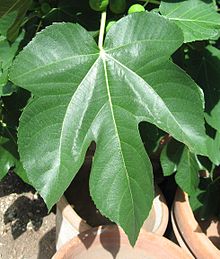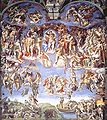Fig leaf


The fig leaf of the fig tree was used in the fine arts to hide the genitals of naked people. In the imagination of the Old Testament it served to overcome feelings of shame by covering one's own nakedness. In times of strict observance of a propriety decorum , it was also added to pictures or when restoring ancient statues.
metaphor
As a metaphor , the fig leaf describes an object that is placed in front of another object in order to conceal it with the intention of not allowing one to be aware of its morally vulnerable property. “To put a fig leaf around someone or something” has the colloquial meaning of the incomplete or makeshift cover-up of an obscene or improper issue. The expression is preferably meant derogatory in the sense of a diversionary maneuver, which is supposed to hypocritically disguise the true facts, and has a proximity to the expression “put on a cover” . Also the phrase “ Don't take a (fig) leaf in front of your mouth. "Or" looking for fig leaves (weaving) "(for excuses, looking for excuses ) point in the same direction.
Biblical symbol
The fig leaf is mentioned in the biblical story of the Fall . After Adam and Eve ate the fruit of the tree of knowledge , they noticed that they were naked and covered their nakedness with fig leaves ( Gen 3.7 EU ). Derived from this text, the “fig leaf” is used as a pictorial expression for the shameful disguise.
Following the example of the biblical text, in the visual arts of the Christian West up to modern times the genitals of a naked person were painted over with a sheet or other covering object. An example of this is the systematic overpainting of the Last Judgment in the Sistine Chapel by the so-called "pants painter" Daniele da Volterra , a pupil of Michelangelo , who carried out the last restoration as much as possible in accordance with the original intentions of the work creator Michelangelo and with the approval of the Catholic Church was withdrawn. For the copy of Michelangelo's David statue in the Victoria and Albert Museum , a plaster fig leaf was specially created to protect female visitors from feeling ashamed.
Adam and Eve ( Hans Baldung ) (around 1520–1525)
Expulsion from Paradise ( Masaccio ) with and without a fig leaf
General symbolism
Today's symbolic representation of a heart goes back, among other things, to stylized fig leaves, together with the leaves of ivy .
Web links
Individual evidence
- ↑ http://www.zeno.org/Pierer-1857/A/Feigenblatt?hl=feigenblatt
- ^ Knaur: The German dictionary. Lexicographical Institute, Munich 1985, page 363
- ↑ http://www.zeno.org/Wander-1867/A/Feigenblatt?hl=feigenblatt
- ↑ http://www.vam.ac.uk/collections/sculpture/stories/david/index.html



